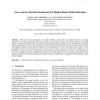Free Online Productivity Tools
i2Speak
i2Symbol
i2OCR
iTex2Img
iWeb2Print
iWeb2Shot
i2Type
iPdf2Split
iPdf2Merge
i2Bopomofo
i2Arabic
i2Style
i2Image
i2PDF
iLatex2Rtf
Sci2ools
IJCV
2006
2006
An a contrario Decision Framework for Region-Based Motion Detection
The aim of motion detection is to decide whether a given part of an image belongs to a moving object or to the static background. This paper proposes an automatic decision rule for the detection of moving regions. The proposed framework is derived from a perceptual grouping principle, namely the Helmholtz principle. This principle basically states that perceptually relevant events are perceived because they deviate from a model of complete randomness. Detections are then said to be performed a contrario: moving regions appear as low probability events in a model corresponding to the absence of moving objects in the scene. A careful design of the events considered under the hypothesis of absence of moving objects results in a general and robust motion detection algorithm. No posterior parameter tuning is necessary. Furthermore, a confidence level is attached to each detected region.
| Added | 12 Dec 2010 |
| Updated | 12 Dec 2010 |
| Type | Journal |
| Year | 2006 |
| Where | IJCV |
| Authors | Thomas Veit, Frédéric Cao, Patrick Bouthemy |
Comments (0)

